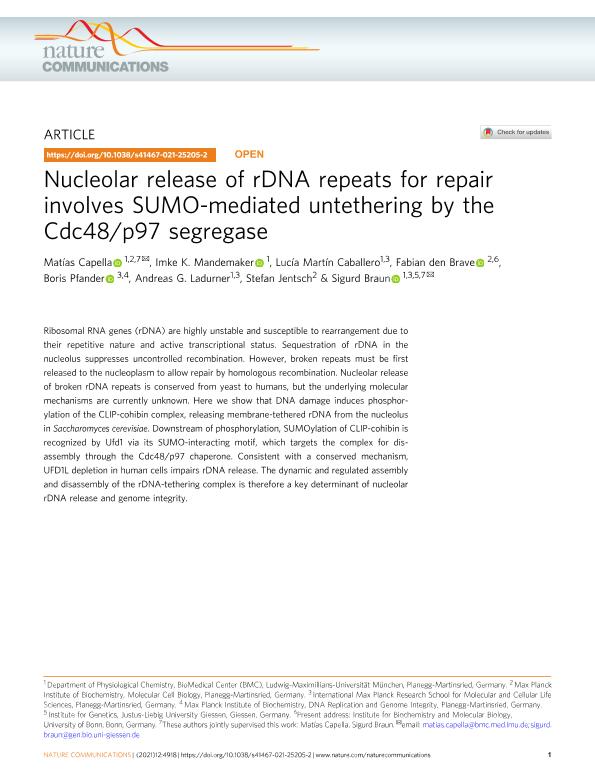Artículo
Nucleolar release of rDNA repeats for repair involves SUMO-mediated untethering by the Cdc48/p97 segregase
Capella, Matias ; Mandemaker, Imke K.; Martín Caballero, Lucía; den Brave, Fabian; Pfander, Boris; Ladurner, Andreas G.; Jentsch, Stefan; Braun, Sigurd
; Mandemaker, Imke K.; Martín Caballero, Lucía; den Brave, Fabian; Pfander, Boris; Ladurner, Andreas G.; Jentsch, Stefan; Braun, Sigurd
 ; Mandemaker, Imke K.; Martín Caballero, Lucía; den Brave, Fabian; Pfander, Boris; Ladurner, Andreas G.; Jentsch, Stefan; Braun, Sigurd
; Mandemaker, Imke K.; Martín Caballero, Lucía; den Brave, Fabian; Pfander, Boris; Ladurner, Andreas G.; Jentsch, Stefan; Braun, Sigurd
Fecha de publicación:
08/2021
Editorial:
Nature Publishing Group
Revista:
Nature Communications
ISSN:
2041-1723
Idioma:
Inglés
Tipo de recurso:
Artículo publicado
Clasificación temática:
Resumen
Ribosomal RNA genes (rDNA) are highly unstable and susceptible to rearrangement due to their repetitive nature and active transcriptional status. Sequestration of rDNA in the nucleolus suppresses uncontrolled recombination. However, broken repeats must be first released to the nucleoplasm to allow repair by homologous recombination. Nucleolar release of broken rDNA repeats is conserved from yeast to humans, but the underlying molecular mechanisms are currently unknown. Here we show that DNA damage induces phosphorylation of the CLIP-cohibin complex, releasing membrane-tethered rDNA from the nucleolus in Saccharomyces cerevisiae. Downstream of phosphorylation, SUMOylation of CLIP-cohibin is recognized by Ufd1 via its SUMO-interacting motif, which targets the complex for disassembly through the Cdc48/p97 chaperone. Consistent with a conserved mechanism, UFD1L depletion in human cells impairs rDNA release. The dynamic and regulated assembly and disassembly of the rDNA-tethering complex is therefore a key determinant of nucleolar rDNA release and genome integrity.
Palabras clave:
Ribosomal DNA
,
Genome stability
,
DNA damage
,
Saccharomyces cerevisiae
Archivos asociados
Licencia
Identificadores
Colecciones
Articulos(IAL)
Articulos de INSTITUTO DE AGROBIOTECNOLOGIA DEL LITORAL
Articulos de INSTITUTO DE AGROBIOTECNOLOGIA DEL LITORAL
Citación
Capella, Matias; Mandemaker, Imke K.; Martín Caballero, Lucía; den Brave, Fabian; Pfander, Boris; et al.; Nucleolar release of rDNA repeats for repair involves SUMO-mediated untethering by the Cdc48/p97 segregase; Nature Publishing Group; Nature Communications; 12; 1; 8-2021; 1-16
Compartir
Altmétricas



